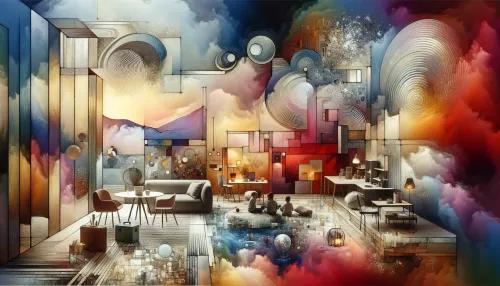
Navigating Nordic Necessity: Scandinavian Approaches to Sensory-Friendly Design for Autistic Children

The Nordic region, known for its emphasis on comfort, nature, and simplicity, has been making significant strides in the development of sensory-friendly designs tailored to meet the needs of autistic children. This article delves into the innovative approaches adopted by Scandinavian countries, shedding light on how these designs are impacting and improving the lives of individuals on the autism spectrum.
How the Nordic concept of ‘hygge’ influences sensory room designs for autistic individuals
The Danish term ‘hygge’, which conveys a sense of comfort, contentment, and well-being, has been instrumental in shaping sensory room designs for autistic individuals across the Nordic region. These spaces prioritize creating an environment that promotes relaxation and stimulation control, aligning with the core principles of hygge. As we recognize the significance of incorporating hygge-inspired sensory room designs to enhance the well-being of autistic children.
Innovative use of natural light and materials in creating calming spaces for those on the spectrum
In Scandinavia, there is a conscious effort to harness natural light and utilize organic materials in designing calming spaces for individuals on the autism spectrum. This approach is deeply rooted in the belief that natural elements foster a sense of tranquility and cohesiveness with the surrounding environment. Acknowledging the importance of integrating these elements into sensory-friendly designs to support the specific needs of autistic children.
Integrating the outdoors: Scandinavia's unique approach to blending nature with therapeutic environments
Scandinavian countries have pioneered the integration of outdoor settings into therapeutic environments for autistic individuals. Leveraging the natural landscape, these designs offer multifaceted sensory experiences while promoting a connection with nature. It's essential to recognize the positive impact of this approach and supports initiatives that aim to blend outdoor elements with therapeutic spaces, catering to the unique sensory requirements of autistic children.
Emphasizing simplicity and minimalism in designing autism-friendly classrooms and homes
The Scandinavian design ethos revolves around simplicity and minimalism, and this philosophy seamlessly extends to the creation of autism-friendly classrooms and homes. By minimizing visual clutter and employing clean, uncomplicated layouts, these environments cater to the sensory sensitivities of individuals on the autism spectrum. Acknowledging the efficacy of this design approach in mitigating sensory overload for autistic children in educational and residential settings.
Case Study: Sweden's pioneering outdoor educational settings for enhanced sensory experiences
Sweden has emerged as a leader in developing outdoor educational settings tailored to provide enhanced sensory experiences for autistic children. These settings leverage nature's inherent therapeutic properties to create dynamic learning environments that foster holistic development. "HorizonsMind" recognizes Sweden's groundbreaking efforts and advocates for similar initiatives aimed at enhancing sensory experiences through outdoor educational settings.
Denmark’s embrace of autistic artists in redefining sensory-friendly interior design
Denmark has embraced autistic artists in redefining sensory-friendly interior design, celebrating their unique perspectives and insights. This inclusive approach not only enriches design concepts but also empowers autistic individuals to contribute meaningfully to the creation of spaces that accommodate their sensory needs. "HorizonsMind" applauds Denmark’s commitment to inclusive design practices that amplify the voices of autistic artists, thereby reshaping sensory-friendly interior spaces.
Norwegian technology meets traditional craftsmanship in creating therapeutic toys for sensory play
Norway excels in merging advanced technology with traditional craftsmanship to develop therapeutic toys tailored for sensory play among autistic children. These thoughtfully crafted toys are designed to engage and stimulate various senses while offering opportunities for creative expression and exploration. Acknowledging the value of integrating technology and traditional craftsmanship to produce purposeful toys that support sensory play experiences for autistic children.
The role of community-driven design in Finland’s autism support schools
In Finland, community-driven design takes center stage in shaping autism support schools, reflecting a collective effort to create inclusive and accommodating educational environments. This collaborative approach ensures that the unique needs of autistic children are carefully considered, ultimately fostering a sense of belonging and empowerment within school settings. Emphasizing the importance of community-driven design in advocating for autism support schools that prioritize inclusivity and accessibility.
Exploring the effectiveness of Scandinavian sensory gardens in autism therapy
Scandinavian sensory gardens have emerged as integral components of autism therapy, offering diverse sensory stimuli within natural outdoor settings. These purposefully designed gardens provide opportunities for calming retreats, exploratory activities, and sensory regulation, aligning with the therapeutic goals of autism therapy. "HorizonsMind" underscores the significance of utilizing Scandinavian-inspired sensory gardens as valuable therapeutic resources in supporting the developmental progress and well-being of autistic children.
As evidenced by these innovative approaches across Scandinavia, there is a growing recognition of the importance of holistic and sensory-focused designs in accommodating the unique needs of autistic children. The integration of natural elements, community involvement, inclusive practices, and technology-driven solutions underscores a collective commitment to creating environments that honor individual differences while promoting comfort and well-being.
By championing these progressive initiatives within "HorizonsMind," we aim to elevate awareness and advocate for inclusive designs that prioritize the diverse needs of individuals on the autism spectrum. As we continue to explore evolving trends and best practices in sensory-friendly design, our commitment remains unwavering in supporting meaningful advancements that positively impact the lives of autistic children.


